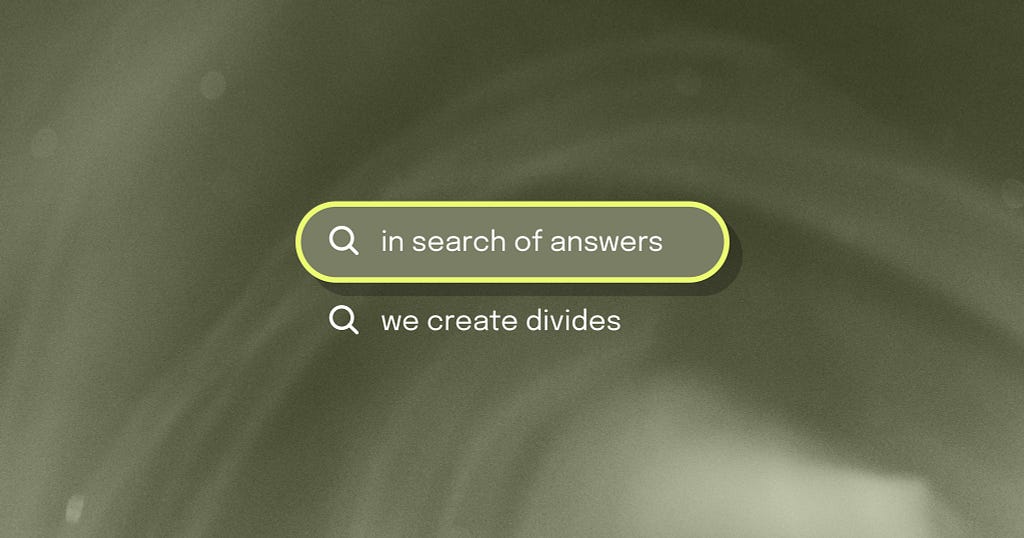The usability and sellability of things are becoming one and the same, but it’s still too narrow a view.
In search of answers, we create divides.

How many times have you been in a conversation that’s started with a question, and ended with: “Huh, I don’t know the answer. Let me Google that (or ask ChatGPT).” We grab our phones. Find AN answer. And feeling like we’ve gotten what we needed, it’s the end of the discussion. Next topic. Moving on.
The internet has given us so much when it comes to access to information. The answers to nearly every question we could ever imagine are at our fingertips. But what if instant answers aren’t as simple, or easy, or even as “right” as we’ve been led to believe? Quite the contrary, they can actually lead to problems in the long-run.
Simple answers only work for simple questions.
Some questions, like “Where is the nearest coffee shop?” or “What’s the current price of gasoline,” are fairly simple questions. As humans, we’ve become aware of the algorithms at play, and when looking for the answer, we’re able to take the search results for what they are, and decide on which ones we want to use without too much internal conflict. These questions are often tension-free, and searching for an answer gives us an objective (or at least, a reasonably acceptable) answer.
However, bigger questions like “How do we solve poverty” or “How do we battle climate change?” add complexity to our search. We can refer to these problems as “Wicked Problems.”
The term “Wicked Problem” was coined by Horst Rittel, a design theorist and professor of design methodology at the Ulm School of Design, Germany. Wikipedia describes a wicked problem as: “a problem that is difficult or impossible to solve because of incomplete, contradictory, and changing requirements that are often difficult to recognize. It refers to an idea or problem that cannot be fixed, where there is no single solution to the problem; and ‘wicked’ denotes resistance to resolution, rather than evil.”
In essence, these are complex, systematic problems that need a systematic lens, working across differences of beliefs and opinions. But in a world that moves faster every day, we’re trained to want to find the answers quickly, and without too much thinking or collaboration.
Googling reinforces our differences, and limits healthy conflict.
Relying on simple answers through quick searches brings us further away from the people we’re with. We no longer take the time to talk things through and connect on a human level. Our discussions become debates where each side uses their online sources to support their own truth. Soon, we’re trapped in an “us versus them” mentality, and things become about winning rather than understanding all sides.
One of my favorite organizations when it comes to creating a world where we all belong, is The Bridging and Belonging Institute. They imagine a world where we can bridge differences and create spaces where different perspectives can co-exist alongside each other. Their practice of “bridging” “is aimed at crossing identity-based lines and is an essential tool for building belonging. To bridge involves two or more individuals or groups coming together across acknowledged lines of difference in a way that both affirms their distinct identities, and allows for a new, more expansive identity.”
Googling quick answers doesn’t just take away the joy and essential practice of a healthy discussion, it also limits our ability to bridge across differences and create environments of belonging.
Googling teaches us that we can fix our feelings.
When we think that answers are one click away, our own feelings also become problems to be solved rather than something to be felt. When we feel ANYTHING, physically or emotionally, we google the symptoms, and before we know it, we’re down a rabbit hole of holistic, scientific, and Reddit articles for how to fix our pain.
But pain is not always a problem. Being with our feelings, letting them move through our body with care and ease, and processing them fully is often the things that make them subside.
My favorite meditation teacher is Pema Chöndrön. She is a Buddhist, author, nun, and mother whose work gives insight into how we can create space to sit with our emotions. In her book When Things Fall Apart: Heart Advice for Difficult Times she writes: “Things falling apart is a kind of testing and also a kind of healing. We think that the point is to pass the test or to overcome the problem, but the truth is that things don’t really get solved. They come together and they fall apart. Then they come together again and fall apart again. It’s just like that. The healing comes from letting there be room for all of this to happen: room for grief, for relief, for misery, for joy.”
Feelings are not there to be fixed. They are there to be felt.
It’s human to want to know. But the world is filled with things that can’t be proved with a few clicks or through a quick conversation with Ai. As designers, we love asking questions. In design thinking, every challenge starts with the question “how might we…” It opens up for curiosity and gives room for exploration.
Becoming ok with not knowing, and resisting the urge to google an answer, gives us the ability to hold complexity within us and around us. It helps us to cultivate healthy relationships with ourselves and others, and it helps us sit with feelings in times of internal turmoil.
If we want to work towards building a world where not knowing and contradictions are central parts as we try to explore challenge problems. We must resist the urge to fix our feelings, and instead feel them. We must recognize our tendencies to rush to solutions and instead find spaces where conversations can take place and instead look at the person next to us and say: I don’t know the answer. Let’s think of some possible scenarios (not solutions) together.
Asking the hard questions (and resisting the urge to ask ChatGPT) was originally published in UX Collective on Medium, where people are continuing the conversation by highlighting and responding to this story.


Leave a Reply